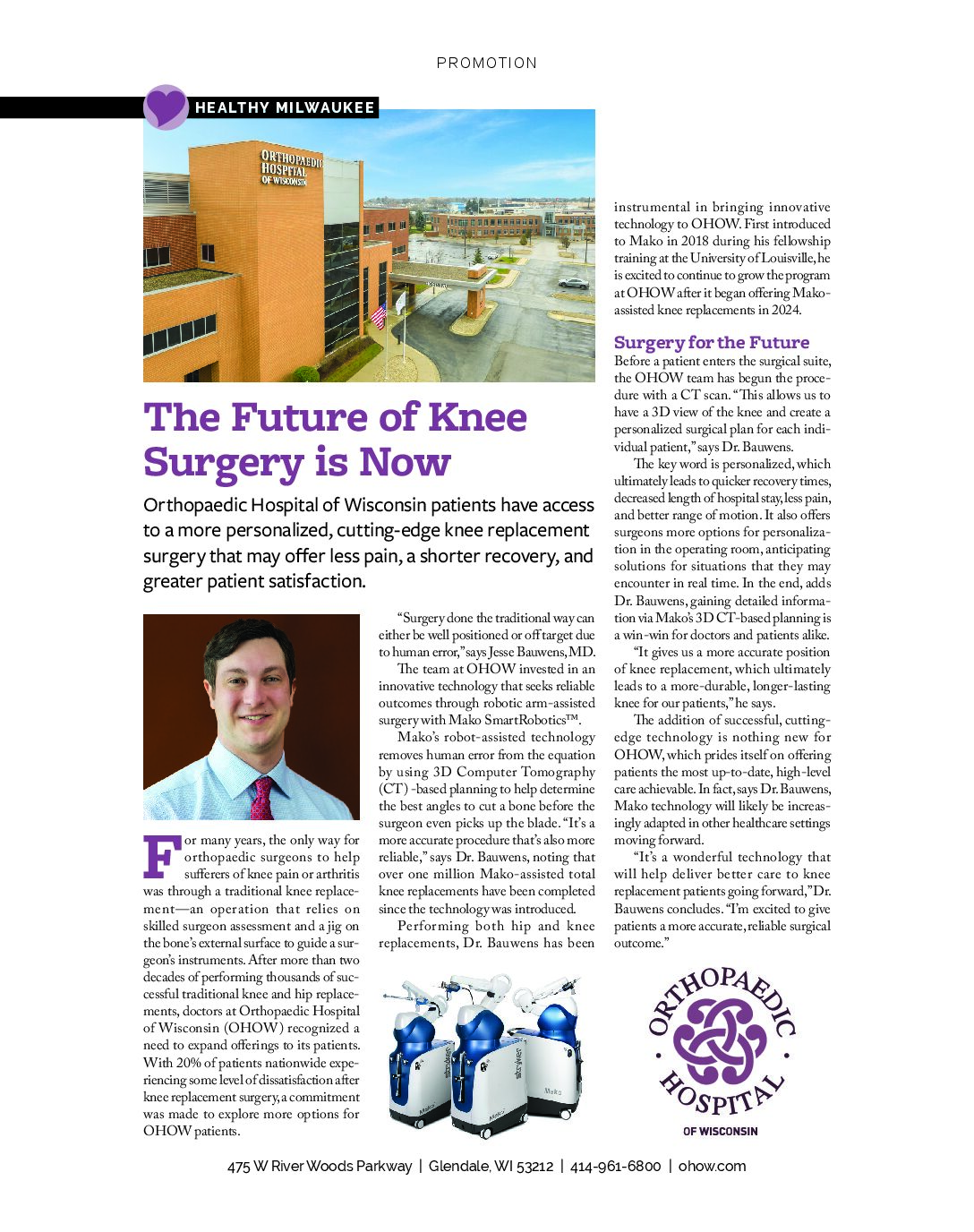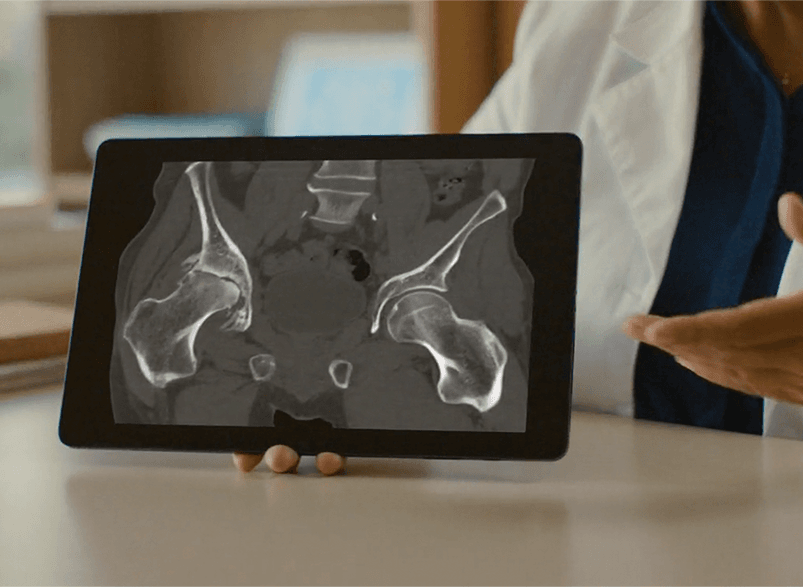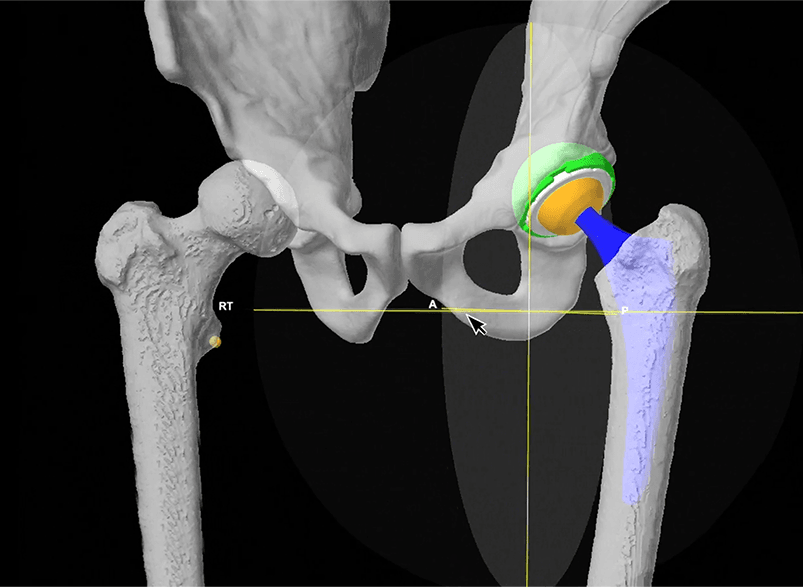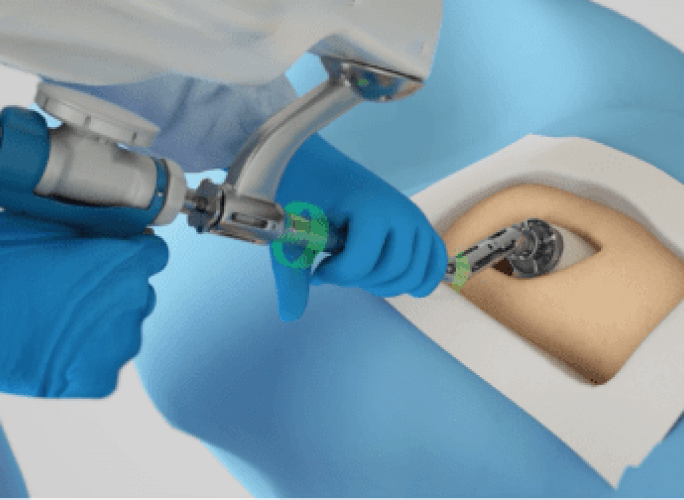The Mako Difference
Mako Total Hip, Total Knee or Partial Knee can help lead to better outcomes, like less pain and shorter recovery times, compared to manual surgery.
In clinical studies, compared to manual replacement surgeries, Mako Robotic-Assisted Technology demonstrated:
- More accurate placement and alignment of hip and knee implants based on the surgical plan.
- Replication of the feeling of a natural hip or knee.
- Less likelihood of hip or knee dislocation.
- Reduced blood loss.
- Preservation of healthy bone.

The journey of Mako Total Hip Replacement (THA) surgery
Step 1 – Scan
Before surgery, a CT scan of your hip is taken and used to develop a 3D virtual model of your unique joint.

Step 2 – Plan
The second step is patient-specific surgical planning.
Your doctor uses the 3D CT-based model to evaluate your bone structure, disease severity, joint alignment and even the surrounding bone and tissue so that they can determine the desired size, placement and alignment of your implant.

Step 3 – Mako Can
In the operating room, your surgeon guides Mako’s robotic arm to remove arthritic bone and cartilage from the hip. Mako’s Accustop™ technology, creates a virtual boundary that provides tactile resistance to help the surgeon stay within the boundaries defined in your surgical plan.
Throughout the procedure, Mako provides real time data to your surgeon, allowing them to assess the movement and tension of your joint and adjust your surgical plan if desired.
As your surgeon prepares to place the implant into its final position, the robotic arm guides the implant at the desired angle.

Is Mako right for me?
Mako Total Hip Arthroplasty is for people who:
- Experience severe hip pain or stiffness resulting from: noninflammatory degenerative joint disease (including osteoarthritis, traumatic arthritis, or avascular necrosis), rheumatoid arthritis or post-traumatic arthritis.
- Haven’t experienced adequate relief with conservative treatment options, like bracing, medication or joint fluid supplements.
References:
- Shibanuma N, Ishida K, Matsumoto T, et al. Early postoperative clinical recovery of robotic arm-assisted vs. image-based navigated Total hip Arthroplasty. BMC Musculoskelet Disord. 2021;22(1):314.
- Sicat CS, Buchalter DB, Luthringer TA, Schwarzkopf R, Vigdorchik JM. Intraoperative Technology Use Improves Accuracy of Functional Safe Zone Targeting in Total Hip Arthroplasty. J Arthroplasty. 2022;37(7S):S540-S545. doi:10.1016/j.arth.2022.02.038
- Kayani B, Konan S, Thakrar RR, Huq SS, Haddad FS. Assuring the long-term total joint arthroplasty: a triad of variables. Bone Joint J. 2019;101-B(1_Supple_A):11-18. doi:10.1302/0301-620X.101B1.BJJ-2018-0377.R1
- Clement ND, Gaston P, Bell A, et al. Robotic arm-assisted versus manual total hip arthroplasty. Bone Joint Res. 2021;10(1):22-30. doi:10.1302/2046-3758.101.BJR-2020-0161.R1
- Bendich I, Vigdorchik JM, Sharma AK, et al. Robotic Assistance for Posterior Approach Total Hip Arthroplasty Is Associated With Lower Risk of Revision for Dislocation When Compared to Manual Techniques. J Arthroplasty. 2022;37(6):1124-1129. doi:10.1016/j.arth.2022.01.085
- Shaw JH, Rahman TM, Wesemann LD, Z Jiang C, G Lindsay-Rivera K, Davis JJ. Comparison of Postoperative Instability and Acetabular Cup Positioning in Robotic-Assist-ed Versus Traditional Total Hip Arthroplasty. J Arthroplasty. 2022;37(8S):S881-S889. doi:10.1016/j.arth.2022.02.002
- Bukowski BR, Anderson P, Khlopas A, Chughtai M, Mont MA, Illgen RL Improved Functional Outcomes with Robotic Compared with Manual Total Hip Arthroplasty. Surg Technol Int. 2016 Oct 26;XXIX:303-308.
- Suarez-Ahedo, C; Gui, C; Martin, T; Chandrasekaran, S; Domb, B. Robotic-arm assisted total hip arthoplasty results in smaller acetabular cup size in relation to the femoral head size: A Matched-Pair Controlled Study. Hip Int. 2017; 27 (2): 147-152.
Important information
Hip Replacements
Hip joint replacement is intended for use in individuals with joint disease resulting from degenerative and rheumatoid arthritis, avascular necrosis, fracture of the neck of the femur or functional deformity of the hip.
Joint replacement surgery is not appropriate for patients with certain types of infections, any mental or neuromuscular disorder which would create an unacceptable risk of prosthesis instability, prosthesis fixation failure or complications in postoperative care, compromised bone stock, skeletal immaturity, severe instability of the joint, or excessive body weight.
Like any surgery, joint replacement surgery has serious risks which include, but are not limited to, pain, infection, bone fracture, change in the treated leg length (hip), joint stiffness, hip joint fusion, amputation, peripheral neuropathies (nerve damage), circulatory compromise (including deep vein thrombosis (blood clots in the legs)), genitourinary disorders (including kidney failure), gastrointestinal disorders (including paralytic ileus (loss of intestinal digestive movement)), vascular disorders (including thrombus (blood clots), blood loss, or changes in blood pressure or heart rhythm), bronchopulmonary disorders (including emboli, stroke or pneumonia), heart attack, and death.
Implant related risks which may lead to a revision of the implant include dislocation, loosening, fracture, nerve damage, heterotopic bone formation (abnormal bone growth in tissue), wear of the implant, metal and/or foreign body sensitivity, soft tissue imbalance, osteolysis (localized progressive bone loss), audible sounds during motion, and reaction to particle debris. Hip implants may not provide the same feel or performance characteristics experienced with a normal healthy joint.
The information presented is for educational purposes only. Speak to your doctor to decide if joint replacement surgery is appropriate for you. Individual results vary and not all patients will return to the same activity level. The lifetime of any joint replacement is limited and depends on several factors like patient weight and activity level. Your doctor will counsel you about strategies to potentially prolong the lifetime of the device, including avoiding high- impact activities, such as running, as well as maintaining a healthy weight. It is important to closely follow your doctor’s instructions regarding post- surgery activity, treatment and follow-up care. Ask your doctor if Robotic-Arm Assisted Surgery is right for you.
Stryker Corporation or its other divisions or other corporate affiliated entities own, use or have applied for the following trademarks or service marks: AccuStop, Mako, Stryker. All other trademarks are trademarks of their respective owners or holders.

